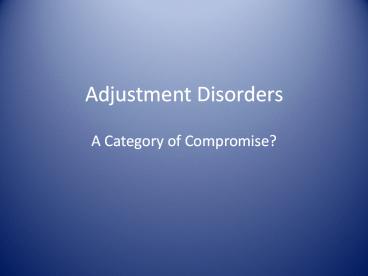Adjustment Disorders - PowerPoint PPT Presentation
Title:
Adjustment Disorders
Description:
Adjustment Disorders A Category of Compromise? Some people react to a major stressor in their lives with extended and excessive feelings of anxiety, depressed mood ... – PowerPoint PPT presentation
Number of Views:2459
Avg rating:3.0/5.0
Title: Adjustment Disorders
1
Adjustment Disorders
- A Category of Compromise?
2
- Some people react
- to a major stressor in their lives
- with extended and excessive feelings of anxiety,
- depressed mood, or antisocial behaviors.
3
- The symptoms do not quite add up
- to acute stress disorder
- or posttraumatic stress disorder,
- nor do they reflect an anxiety or mood disorder
- but they do cause considerable distress or
interfere with the persons job, schoolwork, or
social life.
4
- Should we consider such reactions normal?
5
- No!
- says the DSM-IV-TR
6
- Somewhere between
- effective coping strategies
- and stress disorders
- lie the Adjustment Disorders.
7
The essential feature of Adjustment Disorder is
- The development of clinically significant
- emotional or behavioral symptoms
- in response to an identifiable
- psychosocial stressor or stressors.
8
DSM-IV-TR lists six types of Adjustment
Disorders
- 309.0 With Depressed Mood
- Depressed mood, tearfulness,
- feelings of hopelessness
- 309.24 With Anxiety
- Nervousness, worry, jitteriness, or
- (in children) fears of separation from
- attachment figures.
9
DSM-IV-TR lists six types of Adjustment
Disorders
- 3. 309.28 With Mixed Anxiety and Depressed
Mood - Combination of depressed mood, tearfulness,
feelings of hopelessness - and nervousness, worry, jitteriness, or
- (in children) fears of separation from
- attachment figures.
10
DSM-IV-TR lists six types of Adjustment
Disorders
- 4. 309.3 With Disturbance of Conduct
- Violation of rights of others e.g., truancy,
vandalism, reckless driving, fighting.
11
DSM-IV-TR lists six types of Adjustment
Disorders
- 5. 309.4 With Mixed Disturbance of Emotions
and Conduct - Both emotional symptoms (e.g., depression,
anxiety) and disturbance of conduct
12
DSM-IV-TR lists six types of Adjustment
Disorders
- 309.9 Unspecified
- Maladaptive reactions (e.g., physical
complaints, social withdrawal) that is not one of
the subtypes.
13
Adjustment Disorder (cont.)
- Adjustment Disorder should not be diagnosed if
the reaction to stress is - What might be expected, given the situation
- and
- Does not cause significant impairment in social
or occupation functioning
14
Adjustment Disorder (cont.)
- Characteristics
- Symptoms must develop within 3 months after the
onset of the stressor - Client must have marked distress in excess of
what would be expected given the nature of the
stressor - Diagnosis is not used if disturbance meets the
criteria for another specific Axis I disorder or
is an exacerbation of a preexisting Axis I or
Axis II disorder.
15
Adjustment Disorder (cont.)
- Diagnosis may be used with an Axis I or Axis II
- disorder if they do not account for the
pattern of - symptoms that have occurred in response to
the stressor. - Diagnosis is not used when symptoms represent
Bereavement. - Adjustment Disorder must be resolved within 6
months of termination of the stressor (or its
consequences). - May persist longer than 6 months if it occurs in
response to a chronic stressor
16
Adjustment Disorder (cont.)
- Adjustment Disorders are coded based on subtype
- The subtype is selected according to the
predominant symptom. - The specific stressor(s) can be specified on Axis
IV
17
Adjustment Disorder (cont.)
- Subtypes
- 309.0 With Depressed Mood Depressed mood,
tearfulness, feelings of hopelessness - 309.24 With Anxiety - Nervousness, worry,
jitteriness, or (in children) fears of separation
from attachment figures - 309.28 With Mixed Anxiety and Depressed Mood -
Combination of above) - 309.3 With Disturbance of Conduct - Violation of
right of others (e.g., truancy, vandalism,
reckless driving, fighting) - 309.4 With Mixed Disturbance of Emotions and
Conduct - Both emotional symptoms (e.g.,
depression, anxiety) and disturbance of conduct - 309.9 Unspecified - Maladaptive reactions (e.g.,
physical complaints or social withdrawal) that is
not one of the subtypes.
18
Adjustment Disorder (cont.)
- Specify if
- Acute If the disturbance lasted less than 6
months - Chronic If the disturbance lasts for 6 months
- or longer
19
Differential Diagnosis
- All of the following diagnoses are characterized
by the presence of an extreme stressor - Adjustment Disorder
- Posttraumatic Stress Disorder (PTSD)
- Acute Stress Disorder (AST)
20
Differential Diagnosis
- PTSD and Acute Stress Disorder require an extreme
stressor. - Adjustment Disorder
- Can be triggered by a stressor of any severity,
and - May involve a wide range of possible symptoms.
21
Differential Diagnosis
- With the death of a loved one
- Bereavement is generally diagnosed instead of
Adjustment Disorder. - However, Adjustment Disorder may be used if the
reaction is in excess of, or more prolonged than,
what would be expected.

